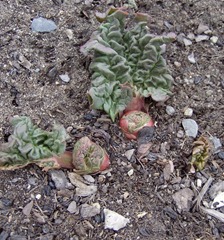The snow has melted, the daffodils are thinking of blooming, and the rhubarb is sending up shoots! Spring is around the corner and this high desert garden in officially open for the season!
I recently purchased a magazine that promised articles on starting a vegetable garden on the cover. I found that the magazine was long on gorgeous pictures, but short on facts. I decided to start a “How to Grow Vegetables and Fruits” series once my garden showed signs of life. It seems fitting to start with rhubarb since their appearance marks the beginning of my spring garden.

Rhubarb is one of my favorite plants to grow, not just because it tastes so good in jellies,
muffins, and
cakes but because it is a
hardy, low-maintenance perennial. Rhubarb is not only very cold hardy (it can survive –20
o F), it is also drought tolerant. It is also relatively free of insects and disease. Once established a rhubarb plant can survive up to 15 years. The only downside to this wonderful plant is that it prefers cooler weather. It does best in locations where the winter is cooler than 40 degrees and the summer time average is 75 degrees. While we meet the winter requirements our summer temperatures greatly exceed 75 degrees. I have compensated by planting my rhubarb in a partially shady location and provide them with extra water during the hot months.
Growing Rhubarb:
Plant rhubarb crowns in the spring. Or start rhubarb seeds in the early fall.
It will do well in most soils, but prefers
fertile, well drained soil. I supplement our soil each year with compost and aged manure.
My friend Melyinda from Mom's Sunday Cafe noticed that you can see part of the crown in the above picture. I took the picture after removing the leaves I had used as mulch and before adding more compost and soil. The crowns will grow each year so they will need a little more soil to keep them covered. After 4 -5 years you can divide them and set them a little lower in the ground again.
Plant at least 2 feet apart. It is hard to believe but these plant can grow 4 feet wide and 3 feet tall.
Plant the roots with the crown buds 2 inches below the surface of the soil.
Rhubarb
can tolerate some shade, so I grow them near my beans and peas.
Rhubarb does not like extreme heat. It will stop producing at temperatures over 90
o F, but will resume again once the temperatures drop in the fall. Rhubarb grows best in the northern U.S., if you live in the southern regions, grow this plant as an annual from seed. Plant the seeds in the early fall and harvest your crop in the spring.
Harvest rhubarb by cutting 3 –4 stems at the soil level per plant. This allows the remaining leaves to generate nutrients to be stored in the roots. New growth will emerge through out the summer and fall. By taking a small amount from each plant, you can harvest rhubarb from April through October.
Cut back flowers and do not let rhubarb plants go to seed.
Rhubarb prefers not to be disturbed, but I did dig them up and move them after they were decimated by rabbits. You will want to divide the crowns every 4 –5 years. Only divide them when they are dormant. Gently dig them up. Then use a sharp knife or spade to divide the root ball into thirds or fourths, making sure each section has some roots, stem, and buds.
Prepare rhubarb for winter by
mulching with 2 inches of leaves, compost, or straw.
Safety Tip:
Only the stalk is edible. DO NOT eat the rhubarb leaves or roots as they contain high levels of oxalic acid which is toxic.
Have you grown rhubarb before?
To peek into other gardens around the country, visit
Garden Tuesday and
Tuesday Garden Party.

